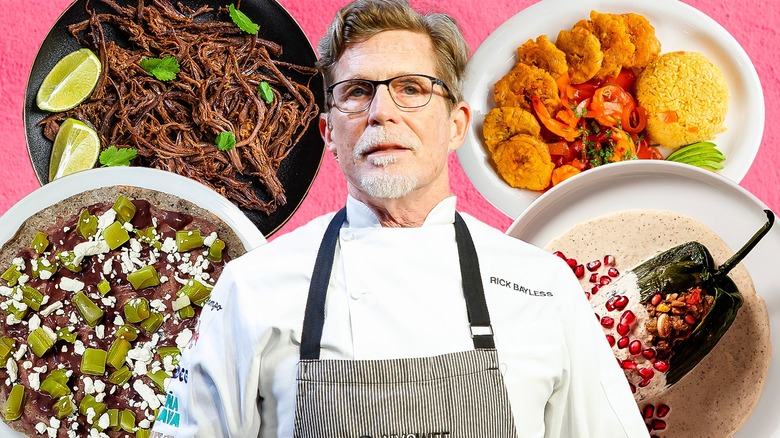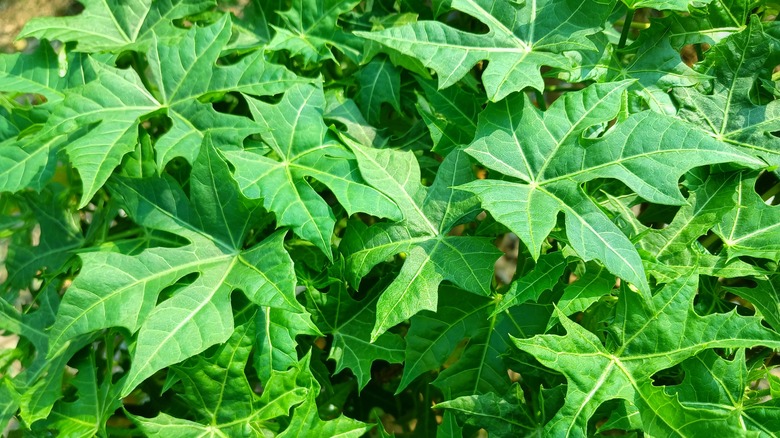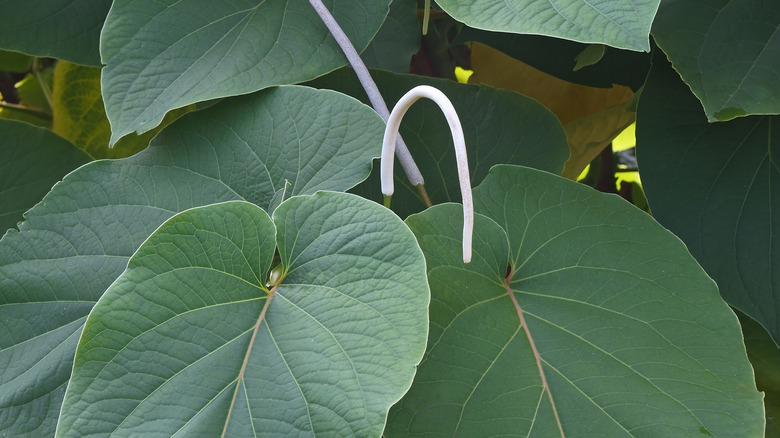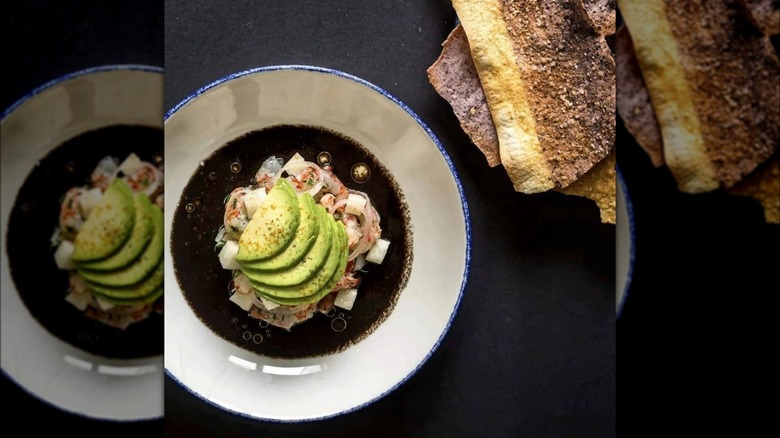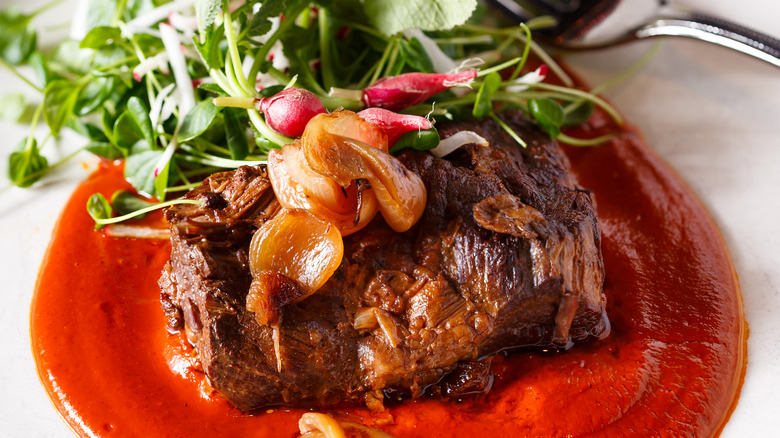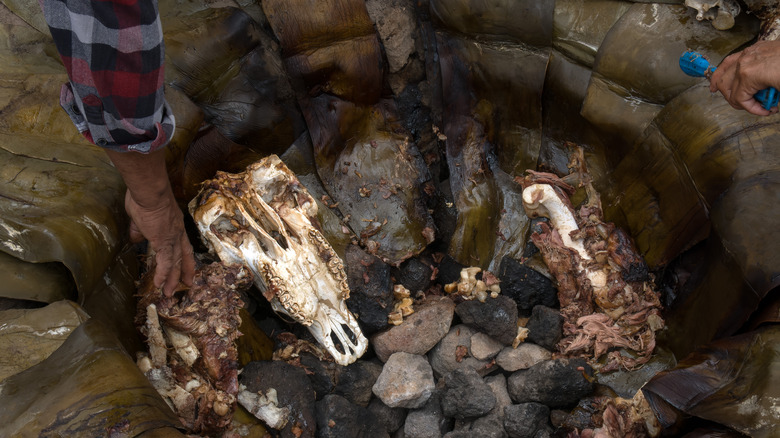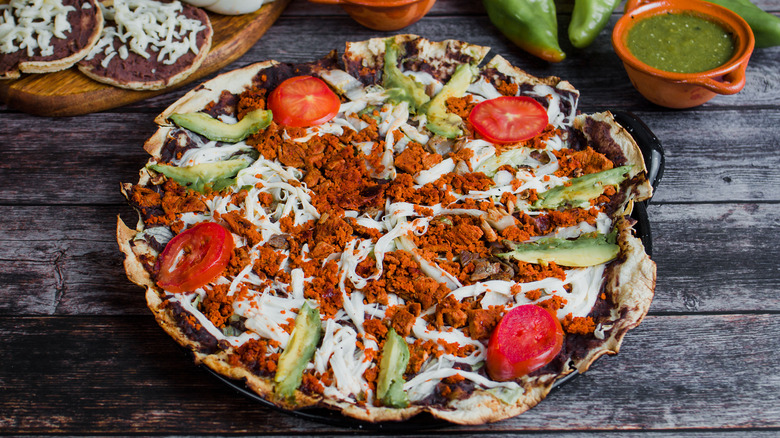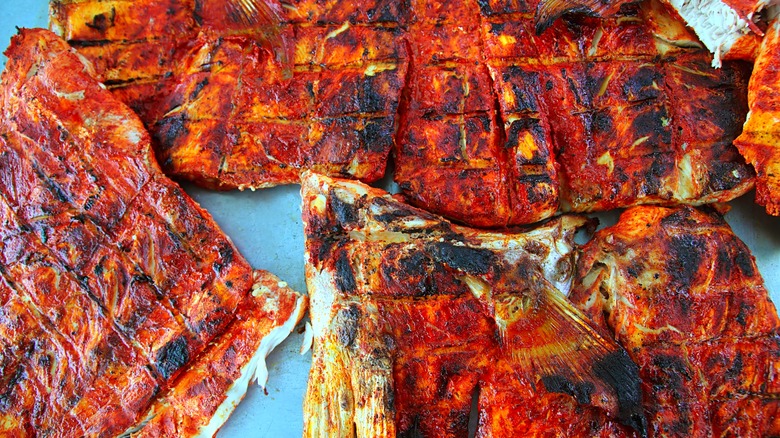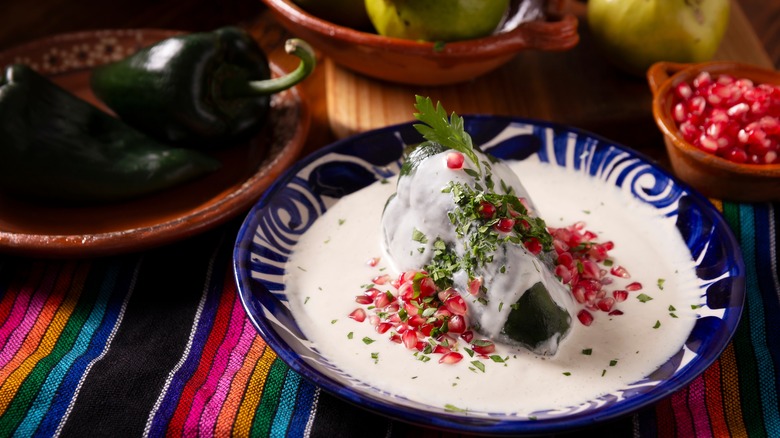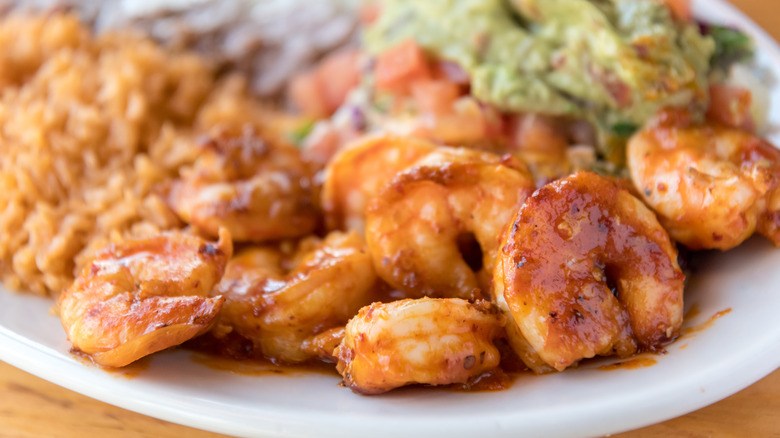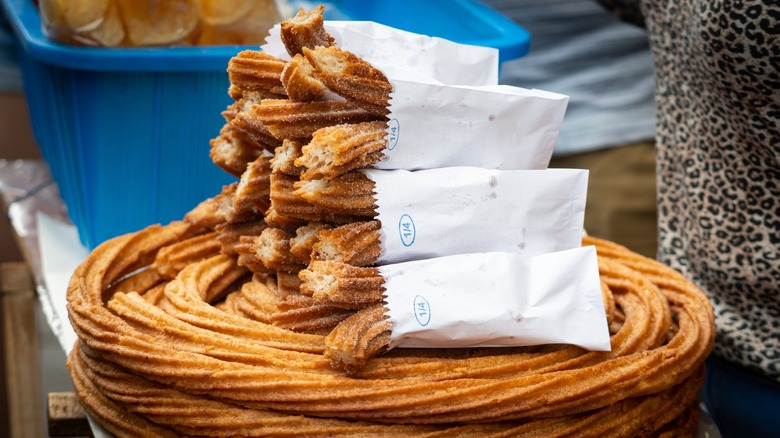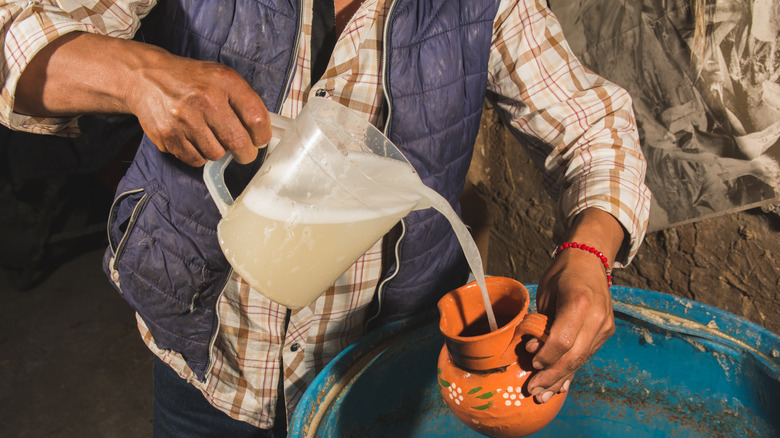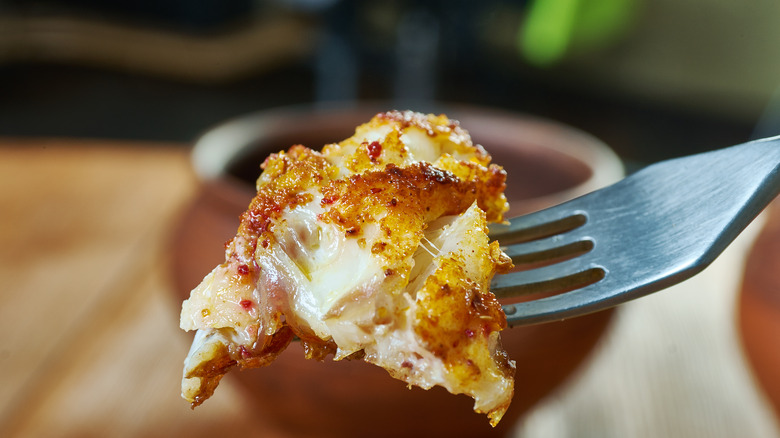12 Underrated Mexican Dishes Rick Bayless Wants You To Know About
Regional cuisine is often highly indicative of place, culture, and people. It's why, when you travel (and eat) across the world, you're likely to come across so many different dishes and the culture that is emulated in every bite. Mexican cuisine, in particular, is filled with an array of inviting flavors and history. It's something that chef and restaurateur Rick Bayless knows rather well.
Bayless — who owns Frontera Grill and Topolobampo, and is well-known for his public television series, "Mexico — One Plate at a Time," as well as his win on "Top Chef Masters" — has come to appreciate the diversity of ingredients and dishes stemming from Mexico. We had an opportunity to sit down with him to discuss some of his favorite eats (and drinks) in the country, and ones that he would recommend that everyone who visits the country tries at least once. After all, Mexican cuisine is far more than tacos and margaritas.
1. Chaya leaves
The different regional growing conditions and topography of Mexico allows for the proliferation of unique ingredients that aren't found many other places in the world. And in the Yucatán, which borders the Gulf of Mexico and is centered on the aptly named Yucatán Peninsula, has one particular ingredient of its own: chaya.
Chef Rick Bayless explains that chaya is a flavorful green found in the region that can be used for a host of different regional dishes. Bayless shares that up until somewhat recently, it was difficult to find this leafy green in the United States, but he has now taken up growing it in his backyard due to its flavor and its nutritional properties. "The thing about that green is that it really is one of the most flavorful ones that I have ever had," he says. Bayless notes that its consistency doesn't resemble pungent brassicas, like cabbage, but it does still have that green, fresh flavor that makes it unique.
Bayless shares that there are three primary ways that chaya is used. The first is for agua de chaya, a smoothie-esque beverage, and the second is as a flavorful addition to scrambled eggs. The last application is in brazo de reina, which he shares is often translated to "queen's arm" because, well, it's about as big as your forearm. This tamal-like roll is stuffed with chaya and masa and seasoned with ingredients like hard-boiled eggs and pumpkin seeds.
2. Hoja santa
Hoja santa's large, heart-shaped green leaves set it apart from other botanical species. Although hoja santa is a popular find in Oaxaca, Rick Bayless explains that it's slowly making its way northward into America; he remarks that they've been cultivating this plant in Chicago for nearly 25 years. Hoja santa is an important ingredient in two different preparations of Mexican mole: the yellow and the green variety. "I'm always encouraging people when they go to Oaxaca to make sure that [they] get a taste of those two because that's where you're really going to see that presence of hoja santa flavor," Bayless says. He describes the flavor of these leaves as having a sarsaparilla and anise-like flavor, or what he calls an "old-fashioned root beer-like flavor."
Besides moles, you can also find hoja santa used in a unique type of tortilla found in Mexico. Based on its flavor, it's easy to see how this leaf could be added to several different dishes to impart a licorice-like undertone to them.
3. Recado negro
Rick Bayless notes that the Yucatán is well-known for its spice pastes, called recado. He explains that there are three primary varieties: blanco, rojo, and negro. However, since recado negro is one of the more difficult ones to find outside of the Yucatán, Bayless makes a point for folks traveling to the area to try it. This spice blend is very complex, and brimming with flavor from dried chiles, achiote paste, allspice berries, Mexican oregano, and cumin.
He recounts one dish, called but negro, as having an excellent flavor. "It's a little bit like a meatloaf," Bayless says, "but it's got this black seasoning paste in it, and that's really super delicious." This dish is traditionally made with ground meat, in addition to onions, peppers, eggs, and tomatoes. You'll find it served with hard-boiled eggs, as well as tortillas.
4. Chichilo
Mole is integral to the fabric of Mexican cuisine, so it isn't surprising to see that chef Rick Bayless has reverence for this tasty and complex sauce. One particular iteration that he can't get enough of is chichilo; it's so tied to the region that you won't find it in the United States. Bayless explains that this is a mole made with dark chiles and avocado leaves. "Avocado leaves are available in lots of Mexican grocery stores," he says, "but the quality is not very good in the ones that we get here in the U.S."
This slightly sweet mole is used in several different Oaxacan dishes and is typically thickened with corn masa. Besides its unique list of ingredients, other qualities that set it apart from different moles is the fact that it's not made with any nuts or seeds, so it doesn't have the same oily quality to it. It also doesn't have the more acidic ingredients present in other moles, including tomatoes and tomatillos. Moreover, chichilo gets its flavors from the blackened chili peppers, which can include chile varieties like mulatos, pasillas, and guajillos.
5. Barbacoa and birria
American eaters are likely no stranger to barbacoa and birria. These styles (as barbacoa translates to "barbecue") of cooking meats, of which is often used for different taco styles, has popped up in Mexican and Tex-Mex restaurants around the U.S. But, as Rick Bayless explains, the American iterations of these dishes won't hold a candle to what you can find in Mexico.
"I always recommend people have [barbacoa and birria in Mexico]," he says. "Because being able to do so, especially pit-cooked barbacoa, in the United States is almost impossible." Bayless goes on to explain that barbacoa in central Mexico, which is often made with lamb, is cooked in open pits. In Oaxaca, you can expect to see this meat coated in a tasty, red chile marinade. In comparison, the barbacoa that you'd find in central Mexico, which includes Mexico City and northward, is made without a marinade; it uses salt and avocado leaves instead. These leaves, Bayless explains, are kept on the branches — which is clearly hard to replicate in an indoor kitchen.
One of Bayless' favorite spots in Mexico City for this style of barbecue is Arroyo. But the food is only part of the draw here. Bayless remarks that the restaurant seats over 2,000 and comes with live music (that you can have played table-side). He also recommends El Hidalguense, which is also located in Mexico City.
6. Tlayudas
We all love a big, hefty tortilla, smothered in cheese from time-to-time, but tlayudas probably aren't like any type of flatbread you've seen before. These flatbreads are 14 to 15 inches in size, which shifts them into pizza crust territory. And Rick Bayless shares that this, in fact, is one of the common uses for the tlayudas. He explains that these tortillas are thin and crispy, like a tostada, so they can be used to support an array of hefty toppings. Bayless also says that these tortillas can be tucked with cheese and meats and served — kind of like a quesadilla.
So, what's the big deal with this tortilla? Bayless shares that tlayudas are made with a special type of corn that is endemic to Oaxaca called bolita. Though, he explains that there has been some availability of tlayudas in recent years in the Chicago area, as well as right over the U.S.-Mexico border in Los Angeles. Still, if you want to sample the freshest version, you may have to take a trip to Oaxaca to try the "real deal." And spoiler alert: You'll be glad you did.
7. Tikin xic
Mexico has plenty of coastline, so it isn't surprising to see that it has an array of fish dishes that highlight local catches, as well as local seasonings. One of these is tikin xic, a Yucatán fish dish that's served coated in a spicy achiote marinade. Rick Bayless shares that it's cooked over a wood-fired grill and is wrapped tightly in banana leaves to preserve its moisture. "I always encourage people to seek [this dish] out when they're in the Yucatán Peninsula," Bayless says.
The type of fish can vary for this recipe, though many folks opt to use red snapper, sea bass, or cod for it. The key to preparing this fish dish is to butterfly it correctly. It's important to maximize the surface area so that you can get the perfect amount of seasoning in every bite. Besides the achiote, you'll also find a hint of flavor from the lime, as well as the acidic garnish that it's served with — which may include pickled red onions.
8. Chiles in nogada
Color is equally as important as taste, and nothing celebrates Mexican heritage quite like the chiles in nogada. "Even though you can find this dish being made in a number of Mexican restaurants in the U.S., I will say eating it in Mexico is just an amazing experience," Rick Bayless says. This dish, which is commonly served on Mexican Independence Day, can also be found at festivals and competitions.
This dish has all three colors of the Mexican flag: green from the pepper, white from the sauce, and red from the garnish of pomegranate seeds on top. The unique ingredient in the sauce that sets this dish apart is fresh walnuts. Now, these aren't the stale walnuts that may be sitting in the back of your pantry as you read this; these are fresh enough that you can peel the brown skin off of the fresh walnut meat. Bayless explains that these fresh walnuts, which have created a huge cottage industry and demand in Mexico, help to create the bright white color of the sauce.
9. Camarones a la diabla
Besides its whole fish, Mexico is also known for its array of seafood dishes, including camarones a la diabla. Rick Bayless explains that this recipe is essentially a "bold and tangy" chili-coated shrimp dish. "And in the best places they make it, they saute the shrimp in butter, which is not very common in Mexico," he says. "But it's really, really good with the red chili sauce that goes with that."
If you can't find a way to make it down to Mexico to try this dish, there are some ways to recreate it at home. The sauce can be made by rehydrating dried guajillo chiles and chile de arbol peppers before pureeing them down with other ingredients like tomatoes, garlic, onion, and salt. This might be the way to go if you're someone who is less tolerant to spice, since you can always add less chiles to suit your palate. But if you want the hottest experience possible and are willing to travel down to Mexico to get it, we (and chef Bayless) would wholeheartedly recommend it.
10. Churros
Wait, can't you get churros up here in the States? Although Rick Bayless understands that you can certainly buy churros from most Tex-Mex restaurants, the best ones are made right in the heart of Mexico. While he shares that the country "is not a super dessert culture," they seem to have a big soft spot for these piping hot, fried, cinnamon-sugar-dusted treats. Bayless even goes so far as to say that churros are one of his "favorite things to eat."
Bayless explains that, in Mexico, it's all about the freshness of the churros. The Americanized version of the dessert will try to distract with endless toppings and fillings, while the churro itself is lackluster. For the best churros, Bayless recommends looking for street vendors that will fry the donut-esque treat before your eyes. Or, better yet, he suggests taking a trip to El Moro Churrería in Mexico City, where the churros are fresh-fried — always. "It's worth going to Mexico City just to eat those churros," he says.
11. Pulque
Every culture has its own dishes, and its own alcohols. In Mexico, the apple of Rick Bayless' eye is pulque. This ancient Mexican agave drink is beer-like, per Bayless, and is sourced from a mature agave plant. Mexican spirits experts will know that it's not the same as the popular tequila or mezcal, which are sourced from the heart of the plant. Rather, pulque comes from the sap of the agave, which is called aguamiel.
Bayless explains to us that the process of gathering the sap from the plant is almost ritualistic, and not dissimilar to milking a dairy cow. It has to be collected twice a day, then the milky liquid can be fermented overnight. It will taste slightly different depending on how long it's aged for. He shares that north of Mexico City, pulque is commonly consumed because it's high in nutrients. There's also a historical connection; the Spaniards introduced beer to counter the nutritional and health benefits of this beverage. That being said, you'll still find pulque in Mexico; Bayless recommends going to a pulqueria to try it so that you know you're getting the freshest stuff possible.
12. Pescado zarandeado
Mexico has several fish dishes that are worth trying, per Rick Bayless. Another one of them is pescado zarandeado, which he describes as a "split fish" dish. To prepare it, the fish is sliced and butterflied lengthwise before it's coated in a savory blend of seasonings. You'll find ingredients like soy sauce and garlic in the marinade, as well as ancho or guajillo chiles. After it's well-seasoned, it's grilled over a fire in a wire cage until it's perfectly cooked on all sides.
This dish is popular in the western stretch of Mexico, and the soy sauce on its ingredients list is a nod to the influence of Chinese populations and food culture in the region. The soy sauce meshes quite well with the smokiness from the wood fire underneath, which makes for a well-rounded bite. You could even add some preserved Chinese chiles to this dish for serving. "That dish is spectacular," Bayless says.
